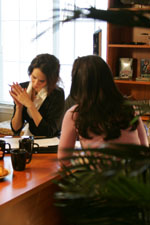Safe Food Temperatures
Temperature converter
Keep hot foods hot and cold foods cold. The "danger zone" is the range between 45°F and 140°F. Bacteria grow most rapidly in the range of temperatures between 40 ° and 140 ° F, doubling in number in as little as 20 minutes.
REFRIGERATE LEFTOVERS WITHIN 2 HOURS
Hot food to be stored in the cooler must be cooled down out of the temperature "danger zone" within 4 hours. Divide large amounts of leftovers into shallow containers for quick cooling in the refrigerator and cover loosely. Stir occasionally to help it cool using a clean spoon each time. Cover tightly when cooled.
Foods stored in a hot holding unit should be stored at 140°F.
Foods that are reheated should be heated to an internal temperature of 165 °F.
Food stored in the refrigerator should be stored at a temperature of 40 °F or less. Use a refrigerator/freezer thermometer to verify that the temperature of the unit is correct.
Food stored in the freezer should be stored at 0 °F.
Raw meat and poultry should always be cooked to a safe internal temperature, (160 ° to 212 °F).
Cook ground meats (beef, veal, lamb, and pork) to an internal temperature of 160 °F, and ground poultry to 165 °F. Steaks and roasts are cooked to an internal temperature of 145 °F are medium rare, 160 °F are medium, and 170 °F are well done .
Food Safety // foodborn illness // food safety glossary // HAACP// employee hygiene // pest control // calibrating thermometers // safe food temperatures // taking food temperatures // health inspections posted online // about restaurant health inspections // handling food safely // using gloves // Dishwashing // work safety // safe food storage // food product recalls / / hand washing // food labeling // keeping your restaurant clean / / defrosting food safely //
|
